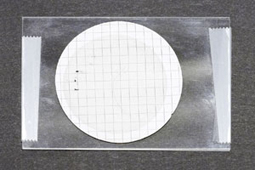|
|
Preparing
a Sample for Counting
Activity 1.2
Student Learning Strategies
This process is very important, since it involves
the filtration of the liquid to capture the particles to be counted
on a sterile gridded membrane filter. If performed incorrectly, the
membrane filter will capture more or fewer number of particles of
various sizes, and the cleanliness level recorded as a result will
be erroneous.
After this activity, students will be able to:
- Perform a blank analysis preparation
used as a baseline for the filtration process.
- Use sterile techniques to avoid contamination
of the sample.
- Use the vacuum/filtration apparatus properly.
- Perform a fluid sample filtration
for the counting procedure.
Procedure
A. Blank Analysis Preparation
This procedure is used as a baseline
for the filtration process.
- With a forceps, grab a membrane filter
and rinse with either filtered alcohol or distilled water.
- Place the membrane filter (grid side up)
on the filter holder base and lock the funnel to the filter with
a clamp.
- Pour 100 ml filtered alcohol or distilled
water from a dispenser into a prepared sample bottle and shake.
- Remove the cap and the filter cover, and
pour the sample (alcohol or distilled water) into the funnel.
- Pour 50 ml alcohol or distilled water from
a dispenser into the sample bottle.
- Pour this sample ( alcohol or distilled
water) into the funnel. Cover the funnel at this time.
- Attach the vacuum to the filter flask and
turn it on. The sample should be filtered until half of the fluid
( 50 ml) remains in the funnel.
- Uncover the funnel, and rinse the funnel
walls ( sides) with the filtered alcohol ( using a dispenser). Do
not dispense the alcohol onto the filter.
- Cover the funnel again, and turn on the
vacuum, to filter the rest of the sample. The filter should appear
dry at this time.
- Remove the clamp, release the vacuum, and
lift the funnel.
- Using a forceps, remove the filter membrane
and place it between 2 glass slides. Do not forget to label your
slide with the specimen's name.
B. Fluid Sample Filtration
Same as above, with some modifications:
- With a forceps, grab a membrane filter
and rinse with filtered alcohol or distilled water.
- Place the membrane filter (grid side up)
on the filter holder base, and lock the funnel to the filter with
a clamp.
- Shake the sample bottle gently and remove
its cap without rotating the film.
- Uncover the funnel and pour the contents
of the sample bottle into the funnel.
- Rinse the sample bottle with 50 ml alcohol
using a dispenser, and pour it into the funnel. Cover the funnel.
- Attach the vacuum to the filter flask and
turn it on. The sample should be filtered until 50 ml of the fluid
remains in the funnel.
- Uncover the funnel, and rinse the funnel
walls with the filtered alcohol (using a dispenser). Do not dispense
the alcohol onto the filter.
- Cover the funnel again, and turn on the
vacuum to filter the rest of the sample untill the filter appears
dry.
- Remove the clamp, release the vacuum, and
lift the funnel.
- Using a forceps, remove the filter membrane
and place it between 2 slides. Label your slides with the name of
the sample.
Note: Perform a particle
count with the Blank Analysis Preparation as well as the
Fluid Sample Preparation. If the Blank Analysis count is
above 10% of the total acceptable sample count, then
the filtration apparatus should be cleaned and the procedure should
be repeated.
Assessment Tools
- What is the purpose for a Blank Analysis
Preparation?
- What is used to rinse the membrane filter?
- Why is the membrane filter placed grid
side up on the filter holder base?
- Why do you need to cover the funnel while
in use?
- Why do you need to rinse the funnel walls
with filtered alcohol after only half of the fluid is filtered?
- What should be performed if the Blank Analysis
count is above 10% of the total acceptable sample count?
Instructor Learning Strategies
Activity level of difficulty: Beginner
Suggested teaching strategies: Students
need a copy of the procedures, and can work in pairs; however, each
student should attempt to operate the vacuum/filtration apparatus
once for familiarization.
Time commitment: 10 to 15 minutes
per procedure; 20 to 30 minutes overall.
Equipment/Materials
- glass filter holder
- filter flask, side arm,
1 liter
- vacuum hose, 1/4"
- solvent filtering dispenser
- solvent filters
- gridded sterile membrane filters
- filter forceps
- vacuum pump
- slides
- glass filter flask cover
- the sample drawn (from the last activity)
Troubleshooting Tips
- The funnel should be covered at all times
to prevent contamination from any possible sources.
- The membrane filter should be positioned
properly on the glass slide so that its sides are parallel to the
sides of the slide. Otherwise, under the microscope, the lines of
the grids will not be straight, which makes the counting very difficult.
Answers to Assessment Tools
- It is used as a baseline for the filtration
process.
- Filtered alcohol or distilled water.
- So that the particles are captured on the
gridded side which is placed on the slide. The grids help in the
counting procedure.
- To reduce contamination from other sources.
- To ensure all the particles go through
the membrane filter including those particles that tend to attach
to the funnel walls as the liquid is vacuumed.
- The filtration apparatus should be cleaned
and the procedure should be repeated.
|
